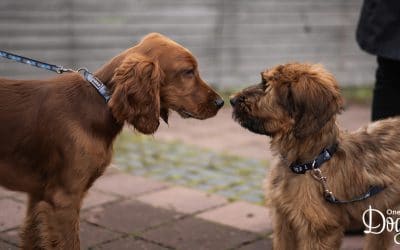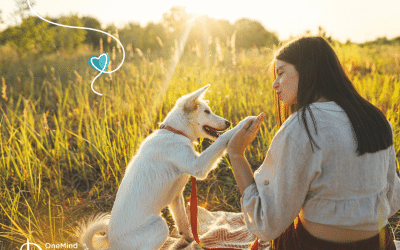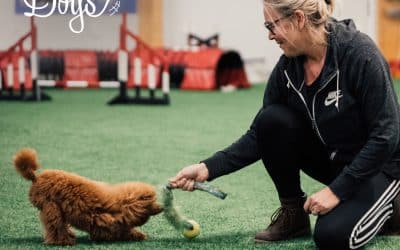Housetraining a puppy is the first thing new puppy parents try to tackle when their pup arrives home. For humans, there’s nothing more icky than stepping on a surprise puddle, or waking up to the smell of something other than coffee.
But from your puppy’s perspective, there’s no difference between peeing on the lawn and peeing on the carpet. Both places are soft, smell good and feel comfortable.
That’s why you need to learn to know when your puppy needs to go and make sure you show them the correct spot for going to the toilet.
For your puppy to learn to do their business outside, you need to reinforce the behavior in the right way, at the right time — like with anything in puppy training, it’s all about creating associations.
As time-consuming and sometimes annoying as it is, housetraining is actually pretty simple. It all comes down to a few main steps:
- Knowing your puppy’s toilet routine
- Supervising your puppy (and confining them when you can’t)
- Understanding that mistakes happen
Step 1: Know your puppy’s toilet routine
We’ve spoken recently about the benefits of creating a puppy training schedule, but with toilet training, having a routine is a must.
It’s usually pretty easy to predict when a puppy needs to go to the toilet:
- After they wake up from a nap (even a short one!)
- Just after eating or drinking (say, 10-20 mins)
- After playing or running around the house
- After having the Zoomies
If any of those situations hasn’t happened, a good rule of thumb is to take them to the correct spot every 30 minutes.
A super helpful thing to teach your puppy is a toilet cue word, like ‘go pee’ or any other word you’d like.
Every time your puppy goes to the toilet outside, say the cue word and give major excited party praise and treats afterwards. Your puppy will eventually learn to associate the cue word with going to the toilet and getting an awesome reward.
Step 2: Supervise your puppy
The only way you’ll know when your puppy needs to go is if you’re watching them. Telltale signs of a busting puppy include:
- Circling and sniffing
- Restlessness
- Moving towards a corner, or place they’ve had an accident before
At the first moment of seeing these signs, it’s time to scoop up your puppy and get them outside to their spot, fast.
If you can’t watch your puppy 24/7 while they’re still being housetrained, you need to plan for it. You could consider:
- Have a friend or family member puppy-sit while you’re out
- Hire a dog minder/walker to take your pup out if you’re away over 1 hour
- Using crate training as a housetraining tool
- Using a puppy pen with a sleeping and potty area
Step 3: Understand that mistakes happen
Sometimes, your puppy won’t be able to hold it, or maybe they just got so excited while playing with you that it just happened. Or, they slept for an extra long time and couldn’t wait a second longer.
The main thing is to not make a big deal of it — quietly take your puppy outside to the correct spot if you catch them mid-way through, and if you don’t, just clean up the mess thoroughly with an enzyme-based cleaner and move on (though this usually means you’ve neglected step 2 a little).
You should never punish your puppy for having an accident inside. It’s unfair to your puppy who doesn’t know better yet — and it might even make them afraid of relieving themselves in front of you.
Puppy housetraining troubleshooting tips:
Q: I take my puppy outside on schedule, and they won’t relieve themselves. Frustrated, we come inside and they immediately pee on the carpet.
This one is all too common with pups who think that inside is a nice, comfortable, relaxing place to do their business.
While you’re outside, you can try these things:
- Go to a familiar spot that your puppy has already been
- Walk in circles with them
- Stay quiet and let them sniff
Then, if you’ve waited patiently outside for 10 minutes and want to go inside, keep your puppy on a leash, tethered to you. This helps you stay alert for the signs, and makes it easier to take them out again in another 10 minutes or so.
Q: My puppy keeps trying to run around and play every time we go out to toilet
The key to this one is staying quiet and calm. From the moment you pick up your puppy to go to their spot, stay quiet. When you put them down in the correct place, stay quiet. Even if they try to play and run around, keep the leash short and don’t give them any attention.
When they do relieve themselves, then it’s party time! Praise, playtime, pats and treats — your puppy needs to know that they’ve done an amazing job, and that they can expect a party every time they do their business outside.
Q: I can tell my puppy needs to do a #2, but they can’t seem to find a good spot. How do I help them?
Ah, the infamous doggy search for the perfect poop spot. Funnily enough, they’re not just trying to kill time (or waste yours!)
They might be circling, spinning and digging to find the most comfortable, quiet spot away from distractions and prying eyes. Or they might be checking in to see which dogs have been there, before deciding whether to relieve themselves there.
Regardless, patience is key — you wouldn’t want someone hurrying you up while you’re on the toilet, right?
Train your puppy right from the start
Every puppy will eventually become house trained if you’re consistent, patient and prepared. Housetraining your puppy will give you both so much freedom, trust and peace of mind when you go to new places together.
For lessons on housetraining, managing puppy biting, leash walking and basically every doggy skill your puppy needs to know, check out our puppy training program — it’s online, flexible and our team of coaches are there to guide you through step-by-step.
Check it out below (and grab your 7-day free trial)




